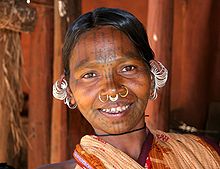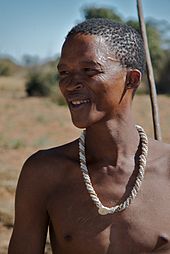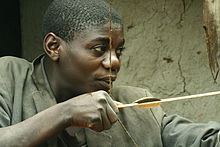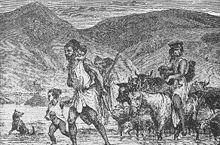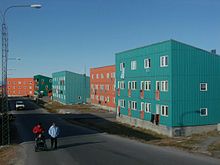- Indigenous peoples
-
This article is about indigenous peoples in general. For links to articles about indigenous people in specific areas, see Indigenous peoples by geographic regions
 Brazilian indigenous chiefs of the Kayapo tribe.
Brazilian indigenous chiefs of the Kayapo tribe.
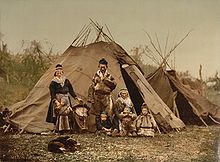 A Sami family in Norway around 1900.
A Sami family in Norway around 1900.
Indigenous peoples, or Natives, are ethnic groups who are native to a land or region, especially before the arrival and intrusion of a foreign and possibly dominating culture. They are a group of people whose members share a cultural identity that has been shaped by their geographical region. A variety of names are used in various countries to identify such groups of people, but they generally are regarded as the "original inhabitants" of a territory or region. Their right to self-determination may be materially affected by the later-arriving ethnic groups.
Contents
Origins of phrase
During the late twentieth century the term Indigenous peoples evolved into a political term that refers to ethnic groups with historical ties to groups that existed in a territory prior to colonization or formation of a nation state. These are usually distinct ethnic groups that have preserved a degree of cultural and political separation from the mainstream culture and political system that has grown to surround or dominate them economically, politically, culturally, or geographically. "'Indigenous peoples' ... is a term that internationalizes the experiences, the issues and the struggles of some of the world's colonized peoples," writes Maori educator Linda Thuwai Smith. "The final 's' in 'indigenous peoples' ... [is] a way of recognizing that there are real differences between different indigenous peoples."[1]
Used politically, the term defines these groups as particularly vulnerable to exploitation and oppression by nation states, and as a result a special set of political rights in accordance with international law have been set forth by international organizations such as the United Nations, the International Labour Organization and the World Bank.[2] The United Nations issued a Declaration on the Rights of Indigenous Peoples, with the intent to protect the collective rights of indigenous peoples to their culture, identity, language, employment, health, education and natural resources.
However, the phrase is not applied consistently in all cultures. The notion of an indigenous group depends on context and other issues. The World Banks policy for indigenous people states:
Because of the varied and changing contexts in which Indigenous Peoples live and because there is no universally accepted definition of “Indigenous Peoples,” this policy does not define the term. Indigenous Peoples may be referred to in different countries by such terms as "indigenous ethnic minorities," "aboriginals," "hill tribes," "minority nationalities," "scheduled tribes," or "tribal groups."[3]Different states designate the groups within their boundaries that are recognized as indigenous peoples according to international legislation by different terms. These include, for example "Native Americans" and "Pacific Islander" in the United States; "Aboriginals (Inuit", "Métis" and "First Nations)" in Canada;[4] Aborigines in Australia; Hill tribes in South East Asia; indigenous ethnic minorities, Scheduled tribes or Adivasi in India; tribal groups, or autochthonous groups.[3]
Definition
Main articles: Definitions and identity of indigenous peoples and Declaration on the Rights of Indigenous Peoples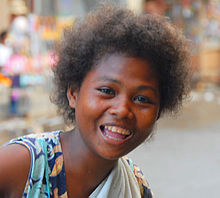 Ati woman, the Philippines, 2007.[5] The Negritos were the earliest inhabitants of Southeast Asia.[6]
Ati woman, the Philippines, 2007.[5] The Negritos were the earliest inhabitants of Southeast Asia.[6]
The adjective indigenous has the common meaning of "from" or "of the original origin". Therefore, in a purely adjectival sense any given people, ethnic group or community may be described as being indigenous in reference to some particular region or location.[7]
Key to a contemporary understanding of "indigenousness" is the political role a cultural group plays, for all other criteria usually taken to denote indigenous groups (territory, race, history, subsistence lifestyle, etc.) can, to a greater or lesser extent, also be applied to majority cultures.[8] Therefore, the distinction applied to indigenous groups can be formulated as "a politically underprivileged group, who share a similar... identity different to the nation in power",[7] and who share territorial rights to a particular area governed by a colonial power. However, the specific term indigenous peoples has a more restrictive interpretation when it used in the more formalized, legalistic, and academic sense, associated with the collective rights of human populations.[7] In these contexts, the term is used to denote particular peoples and groups around the world who, as well as being native to or associated with some given territory,[8] meet certain other criteria (such as having reached a social and technological plateau thousands of years ago).
Criteria
Drawing on these, a contemporary working definition of "indigenous people" for certain purposes has criteria which would seek to include cultural groups (and their continuity or association with a given region, or parts of a region, and who formerly or currently inhabit the region) either:[8]
- before or its subsequent colonisation or annexation; or
- alongside other cultural groups during the formation or reign of a colony or nation-state; or
- independently or largely isolated from the influence of the claimed governance by a nation-state,
and who furthermore:[7]
- have maintained at least in part their distinct cultural, social/organisational, or linguistic characteristics, and in doing so remain differentiated in some degree from the surrounding populations and dominant culture of the nation-state.
To the above, a criterion is usually added to also include:[7]
- peoples who are self-identified as indigenous, or those recognized as such by other groups.
Note that even if all the above criteria are fulfilled, some people may either not consider themselves as indigenous or may not be considered as indigenous by governments, organizations or scholars. The discourse of indigenous / non-indigenous may also be viewed within the context of postcolonialism and the evolution of post-colonial societies.
Characteristics
Population and distribution

Indigenous societies range from those who have been significantly exposed to the colonizing or expansionary activities of other societies (such as the Maya peoples of Mexico and Central America) through to those who as yet remain in comparative isolation from any external influence (such as the Sentinelese and Jarawa of the Andaman Islands).
Precise estimates for the total population of the world's Indigenous peoples are very difficult to compile, given the difficulties in identification and the variances and inadequacies of available census data. Recent source estimates range from 300 million[9] to 350 million[10] as of the start of the 21st century. This would equate to just fewer than 6% of the total world population. This includes at least 5000 distinct peoples[10] in over 72 countries.
Contemporary distinct indigenous groups survive in populations ranging from only a few dozen to hundreds of thousands and more. Many indigenous populations have undergone a dramatic decline and even extinction, and remain threatened in many parts of the world. Some have also been assimilated by other populations or have undergone many other changes. In other cases, indigenous populations are undergoing a recovery or expansion in numbers.
Certain indigenous societies survive even though they may no longer inhabit their "traditional" lands, owing to migration, relocation, forced resettlement or having been supplanted by other cultural groups. In many other respects, the transformation of culture of indigenous groups is ongoing, and includes permanent loss of language, loss of lands, encroachment on traditional territories, and disruption in traditional lifeways due to contamination and pollution of waters and lands.
Common characteristics
Characteristics common across many Indigenous groups include present or historical reliance upon subsistence-based production (based on pastoral, horticultural and/or hunting and gathering techniques), and a predominantly non-urbanized society. Not all indigenous groups share these characteristics. Indigenous societies may be either settled in a given locale/region or exhibit a nomadic lifestyle across a large territory, but are generally historically associated with a specific territory on which they are dependent. Indigenous societies are found in every inhabited climate zone and continent of the world.[2][11]
Common concerns
Indigenous peoples confront a diverse range of concerns associated with their status and interaction with other cultural groups, as well as changes in their inhabited environment. Some challenges are specific to particular groups; however, other challenges are commonly experienced. Bartholomew Dean and Jerome Levi (2003) explore why and how the circumstances of indigenous peoples are improving in some places of the world, while their human rights continue to be abused in others.[12] These issues include cultural and linguistic preservation, land rights, ownership and exploitation of natural resources, political determination and autonomy, environmental degradation and incursion, poverty, health, and discrimination.
The interaction between indigenous and non-indigenous societies throughout history has been complex, ranging from outright conflict and subjugation to some degree of mutual benefit and cultural transfer. A particular aspect of anthropological study involves investigation into the ramifications of what is termed first contact, the study of what occurs when two cultures first encounter one another. The situation can be further confused when there is a complicated or contested history of migration and population of a given region, which can give rise to disputes about primacy and ownership of the land and resources.
In further evidence of how vulnerable some of the Indigenous Peoples are, the Bangladesh Government has stated that there are "no Indigenous Peoples in Bangladesh".[13] This has angered the Indigenous Peoples of Chittagong Hill Tracts, Bangladesh, collectively known as the Jumma (whichs include the Chakma, Marma, Tripura, Tenchungya, Chak, Pankho, Mru, Murung, Bawm, Lushai, Khyang, Gurkha, Assamese, Santal and Khumi).[14] Experts have protested against this move of the Bangladesh Government and have questioned the Government's definition of the term "Indigenous Peoples".[15][16] This move by the Bangladesh Government is seen by the Indigenous Peoples of Bangladesh as another step by the Government to further erode their already limited rights.[17]
Historical cultures
The migration, expansion and settlement of societies throughout different territories is a universal, almost defining thread which runs through the entire course of human history. Many of the cross-cultural interactions which arose as a result of these historical encounters involved societies which might properly be considered as indigenous, either from their own viewpoint or that of external societies.
Most often, these past encounters between indigenous and "non-indigenous" groups lack contemporary account or description. Any assessment or understanding of impact, result and relation can at best only be surmised, using archaeological, linguistic or other reconstructive means. Where accounts do exist, they frequently originate from the viewpoint of the colonizing, expansionary or nascent state or from rather scarce and fragmented ethnographic sources compiled by those more congenial with indigenous communities and/or representatives thereof.
Classical antiquity
Greek sources of the Classical period acknowledge the prior existence of indigenous people(s), whom they referred to as "Pelasgians". These peoples inhabited lands surrounding the Aegean Sea before the subsequent migrations of the Hellenic ancestors claimed by these authors. The disposition and precise identity of this former group is elusive, and sources such as Homer, Hesiod and Herodotus give varying, partially mythological accounts. However, it is clear that cultures existed whose indigenous characteristics were distinguished by the subsequent Hellenic cultures (and distinct from non-Greek speaking "foreigners", termed "barbarians" by the historical Greeks). Greco-Roman society flourished between 250 BC and 480 AD and commanded successive waves of conquests that gripped more than half of the globe. But because already existent populations within other parts of Europe at the time of classical antiquity had more in common culturally speaking with the Greco-Roman world, the intricacies involved in expansion across the European frontier were not so contentious relative to indigenous issues. But when it came to expansion in other parts of the world, namely Asia, Africa, and the Middle East, then totally new cultural dynamics had entered into the equation, so to speak, and one sees here of what was to take the Americas, South East Asia, and the Pacific by storm a few hundred years later. The idea that peoples who possessed cultural customs and racial appearances strikingly different to that of the colonizing power is no new idea borne out of the Medieval period or the Age of Reason. In fact, this idea had its roots in the political and intellectual ideologies of classical antiquity which tended towards dualizing the interdependent composites of nature and culture to the extent that all 'civilized' peoples were seen to be exemplary of a culture that was unequivocally refined and quintessentially separate from nature in its sociorelational characteristics and resultant political ability to embrace unashamedly a conquering mindset informed by what was believed to be the elemental urge and rational inclination towards accumulation of status and wealth.[citation needed] Therefore, this prevailing social belief in the efficacy of a hierarchical order of supreme rationality governed all political decisions both major and minor, in the Greco-Roman world.[18] This is what the culture and politics of expansionism hinged itself upon coupled with a marked disdain for any culture that dared to prop itself up in resistance against this self-interested power. Indigenous cultures that did such actions to counter the acculturative influences of Greco-Roman rule in this period were often met with brute suppression and a magnitude of cultural disintegration equaled in scope during the subsequent latter European colonial period which stretched from the 15th century into the 20th. Two of the most well known of these earlier movements of indigenous resistance include the popular "Zealot" uprisings in ancient Israel which brazenly refuted the self-appointed efficacy and cultural ostentation of Greco-Roman imperial presence and the audacious counter-culture of dissent thrown at imperial Rome by Christian exiles from their traditional territory in Israel,[19] which was thrown into political turbulence in 70 AD.[20]
Alonso Fernández de Lugo presenting the captured Guanche kings of Tenerife to Ferdinand and Isabella.
European expansion and colonialism
The rapid and extensive spread of the various European powers from the early 15th century onwards had a profound impact upon many of the indigenous cultures with whom they came into contact. The exploratory and colonial ventures in the Americas, Africa, Asia and the Pacific often resulted in territorial and cultural conflict, and the intentional or unintentional displacement and devastation of the indigenous populations.
The Canary Islands had an indigenous population called the Guanches whose origin is still the subject of discussion among historians and linguists.[21]
Contemporary distribution and survey
See also: List of indigenous peoples and Indigenous peoples by geographic regionsIndigenous populations are distributed in regions throughout the globe. The numbers, condition and experience of indigenous groups may vary widely within a given region. A comprehensive survey is further complicated by sometimes contentious membership and identification.
Arab Tribal Societies
See also: Arab tribes A Bedouin hunter from Shammar tribe with a shot Asiatic Cheetah and cub from Southwestern Iraq poses with his new Lee-Enfield rifle in 1925.
A Bedouin hunter from Shammar tribe with a shot Asiatic Cheetah and cub from Southwestern Iraq poses with his new Lee-Enfield rifle in 1925.
The Arabian peninsula and adjacent areas are home to numerous indigenous Arab tribes. Both the far eastern seaboard of the Mediterranean and the Arabian Peninsula are home to a vast number of Bedouin tribes that lived in the area since pre-historical times. Many Arab tribes have moved into Africa, South Asia and South East Asia in which case they are not considered indigenous. Remnants of old South Arabian indigenous people are found in Oman and Yemen.
 A northern Arab tribal warrior (ca. 1914) carrying a large Beduine hunting az-zaġāyah on horseback during the Ottoman occupation of Transjordan.
A northern Arab tribal warrior (ca. 1914) carrying a large Beduine hunting az-zaġāyah on horseback during the Ottoman occupation of Transjordan.
Amongst Arabs, a distinction is often made between Adnani Arabs (Arabic: العرب المستعربة) – (Arabized Arabs) and Qathani Arabs (Arabic: قحطان ). Since Islam forbade discrimination on racial grounds and ruled that the offspring of a slave and a free person was to inherit the family name, be an heir and also be set free, there has been a strong foreign impact on the Arab population. Because of historic intercultural intermingling there are now certain tribes that are almost entirely referred to as black and some tribes on the Mediterranean's far eastern seaboard that look similar to what are referred to as white people. In the Gulf countries, in recent times there has been a large number of Pakistani, Indian, Bangladeshi and Persians immigrants that actually outnumber indigenous communities in many smaller states. Many have acquired citizenship trough naturalization. It is believed that these foreign groups will impose a strong future pressure on indigenous populations who are by comparison, relatively small in number. As a general rule tribes in this geographical vicinity do not practice tribal enrollment based on blood quantum as some Native American tribal governments do. It is a mistake to assume that only Bedouin Arabs are members of indigenous tribes. However, there are indigenous tribes who can trace their heritage to one of the many ancient Arabian tribes and there are indigenous groups who, for some reason or other, have lost their tribal names or affiliation due to sedentary live style or other factors.If the latter are to be considered indigenous in the narrow sense, remains subject of debate.
Africa
Main article: Indigenous peoples of AfricaSee also: :Category:Indigenous peoples of AfricaIn the post-colonial period, the concept of specific indigenous peoples within the African continent has gained wider acceptance, although not without controversy. The highly diverse and numerous ethnic groups which comprise most modern, independent African states contain within them various peoples whose situation, cultures and pastoralist or hunter-gatherer lifestyles are generally marginalized and set apart from the dominant political and economic structures of the nation. Since the late 20th century these peoples have increasingly sought recognition of their rights as distinct indigenous peoples, in both national and international contexts.
Although the vast majority of African peoples can be considered to be indigenous in the sense that they have originated from that continent and middle and south east Asia, in practice identity as an "indigenous people" as per the term's modern application is more restrictive, and certainly not every African ethnic group claims identification under these terms. Groups and communities who do claim this recognition are those who by a variety of historical and environmental circumstances have been placed outside of the dominant state systems, and whose traditional practices and land claims often come into conflict with the objectives and policies promulgated by governments, companies and surrounding dominant societies.
 A Tuareg wearing the Tajelmust.
A Tuareg wearing the Tajelmust.
Given the extensive and complicated history of human migration within Africa, being the "first peoples in a land" is not a necessary precondition for acceptance as an indigenous people. Rather, indigenous identity relates more to a set of characteristics and practices than priority of arrival. For example, several populations of nomadic peoples such as the Tuareg of the Sahara and Sahel regions now inhabit areas in which they arrived comparatively recently; their claim to indigenous status (endorsed by the African Commission on Human and Peoples' Rights) is based on their marginalization as nomadic peoples in states and territories dominated by sedentary agricultural peoples.
The Indigenous Peoples of Africa Co-ordinating Committee (IPACC) is one of the main trans-national network organizations recognized as a representative of African indigenous peoples in dialogues with governments and bodies such as the UN. IPACC identifies several key characteristics associated with indigenous claims in Africa:
- political and economic marginalization rooted in colonialism;
- de facto discrimination based often on the dominance of agricultural peoples in the State system (e.g. lack of access to education and health care by hunters and herders);
- the particularities of culture, identity, economy and territoriality that link hunting and herding peoples to their home environments in deserts and forests (e.g. nomadism, diet, knowledge systems);
- some indigenous peoples, such as the San and Pygmy peoples are physically distinct, which makes them subject to specific forms of discrimination.
With respect to concerns expressed that identifying some groups and not others as indigenous is in itself discriminatory, IPACC states that it:
- "...recognises that all Africans should enjoy equal rights and respect. All of Africa's diversity is to be valued. Particular communities, due to historical and environmental circumstances, have found themselves outside the state-system and underrepresented in governance...This is not to deny other Africans their status; it is to emphasise that affirmative recognition is necessary for hunter-gatherers and herding peoples to ensure their survival."
At an African inter-governmental level, the examination of indigenous rights and concerns is pursued by a sub-commission established under the African Commission on Human and Peoples' Rights (ACHPR), sponsored by the African Union (AU) (successor body to the Organization of African Unity (OAU)). In late 2003 the 53 signatory states of the ACHPR adopted the Report of the African Commission's Working Group on Indigenous Populations/Communities and its recommendations. This report says in part (p. 62):
- ...certain marginalized groups are discriminated in particular ways because of their particular culture, mode of production and marginalized position within the state[; a] form of discrimination that other groups within the state do not suffer from. The call of these marginalized groups to protection of their rights is a legitimate call to alleviate this particular form of discrimination.
The adoption of this report at least notionally subscribed the signatories to the concepts and aims of furthering the identity and rights of African Indigenous peoples. The extent to which individual states are mobilizing to put these recommendations into practice varies enormously, however, and most Indigenous groups continue to agitate for improvements in the areas of land rights, use of natural resources, protection of environment and culture, political recognition and freedom from discrimination.
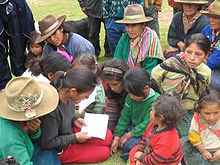 Peruvian indigenous people, learning to read.[22]
Peruvian indigenous people, learning to read.[22]
Americas
Main article: Indigenous peoples of the AmericasIndigenous peoples of the American continents are broadly recognized as being those groups and their descendants who inhabited the region before the arrival of European colonizers and settlers (i.e., Pre-Columbian). Indigenous peoples who maintain, or seek to maintain, traditional ways of life are found from the high Arctic north to the southern extremities of Tierra del Fuego.
 A Choctaw Belle (1850)
A Choctaw Belle (1850)
The impact of European colonization of the Americas on the indigenous communities has been in general quite severe, with many authorities estimating ranges of significant population decline due to the ravages of various genocide campaigns, epidemic diseases (smallpox, measles, etc.), displacement, conflict, compulsory boarding schools, massacres and exploitation. The extent of this impact is the subject of much continuing debate. Several peoples shortly thereafter became extinct, or very nearly so.
All nations in North and South America have populations of indigenous peoples within their borders. In some countries (particularly Latin American), indigenous peoples form a sizable component of the overall national population—in Bolivia they account for an estimated 56%–70% of the total nation, and at least half of the population in Guatemala and the Andean and Amazonian nations of Peru. In English, indigenous peoples are collectively referred to by several different terms which vary by region and include such ethnonyms as Native Americans, Amerindians, Indians. In Spanish or Portuguese speaking countries one finds the use of terms such as pueblos indígenas, amerindios, povos nativos, povos indígenas, and in Peru, Comunidades Nativas, particularly among Amazonian societies like the Urarina[23] and Matsés.
In Brazil, the term índio (Portuguese pronunciation: [ˈĩdʒi.u] or ˈĩdʒju) is used by most of the population, the media, the indigenous peoples themselves and even the government (FUNAI is acronym for Fundação Nacional do Índio), although its Hispanic equivalent indio is widely not considered politically correct and falling into desuse. Nevertheless, Portuguese for Amerindian and amerindio, ameríndio (ameˈɾĩdʒi.u or ameˈɾĩdʒju in the standard South American dialects) is gaining some popularity, still, it seems odd for many. The widespread completely politically correct term of which Brazilians are used to is indígena ĩˈdʒiʒenɐ (although its literal translation is "indigenous person or peoples from anywhere", it is colloquially intended as synonym for Amerindian, without need for specifications in reference to the indigenous peoples of what continent; South American Portuguese for Inuit is either esquimó eskiˈmɔ or the much less common inuíte ĩnuˈitʃi, and they are not considered ameríndios or índios but indígenas do Ártico, or even far more colloquially povo do Polo Norte, "the people from the North Pole"). It has more ethnic meanings than racial ones, and a "Westerner" in Brazil can be an acculturated ameríndio/índio but not an indígena, which officially means indigenous in the narrow sense; when somebody in the former acknowledges it, will usually choose the racial group of Pardos (colored and multiracial people i.e. everyone who does not fall into White, East Asian, Indigenous or African Brazilian) and very seldom Asian Brazilians (brasileiros de cor amarela, lit. yellow skin color but actually "yellow race") in censuses, since there is no category that groups Amerindians together by race in IBGE.
Aboriginal peoples in Canada comprise the First Nations,[24] Inuit[25] and Métis.[26] The descriptors "Indian" and "Eskimo" are falling into disuse in Canada.[27][28] There are currently over 600 recognized First Nations governments or bands encompassing 1,172,790 2006 peoples spread across Canada with distinctive Aboriginal cultures, languages, art, and music.[29][30][31] National Aboriginal Day recognises the cultures and contributions of Aboriginals to the history of Canada
The Inuit have achieved a degree of administrative autonomy with the creation in 1999 of the territories of Nunavik (in Northern Quebec), Nunatsiavut (in Northern Labrador) and Nunavut, which was until 1999 a part of the Northwest Territories. The self-administering Danish territory of Greenland is also home to a majority population of indigenous Inuit (about 85%).
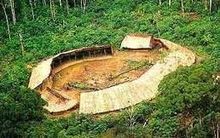 Yanomami village of the Amazon Rainforest.
Yanomami village of the Amazon Rainforest.
In the United States, the combined populations of Native Americans, Inuit and other indigenous designations totalled 2,786,652 (constituting about 1.5% of 2003 US census figures). Some 563 scheduled tribes are recognized at the Federal level, and a number of others recognized at the State level.
In Mexico, approximately 6,011,202 (constituting about 6.7% of 2005 Mexican census figures) identify as Indígenas (Spanish for natives or indigenous peoples). In the southern states of Chiapas, Yucatán and Oaxaca they constitute 26.1%, 33.5% and 35.3%, respectively, of the population. In these states several conflicts and episodes of civil war have been conducted, in which the situation and participation of indigenous societies were notable factors (see for example EZLN).
The Amerindians make up 0.4% of Brazil's population, or about 700,000 people.[32] Indigenous peoples are found in the entire territory of Brazil, although the majority of them live in Indian reservations in the North and Center-Western part of the country. On 18 January 2007, FUNAI reported that it had confirmed the presence of 67 different uncontacted tribes in Brazil, up from 40 in 2005. With this addition Brazil has now overtaken the island of New Guinea as the country having the largest number of uncontacted tribes.[33]
Guatemala is 50 to 80% indigenous, depending on whose statistics are used (Nelson, Finger in the Wound 1999)
Asia
Main article: Indigenous peoples of Asia- See also: Category:Indigenous peoples of Asia
A man of Japanese indigenous people Ainu with a bear around 1930
The vast regions of Asia contain the majority of the world's present-day Indigenous populations, about 70% according to IWGIA figures.
The most substantial populations are in India, which constitutionally recognizes a range of "Scheduled Tribes" within its borders. These various peoples (collectively referred to as Adivasis, or tribal peoples) number about 68 million (1991 census figures, approximately 8% of the total national population).
Nivkh people are an ethnic group indigenous to Sakhalin, having a few speakers of the Nivkh language, but their fisher culture has been endangered due to the development of oil field of Sakhalin from 1990s.[34]
Ainu people are an ethnic group indigenous to Hokkaidō, the Kuril Islands, and much of Sakhalin. As Japanese settlement expanded, the Ainu were pushed northward, until by the Meiji period they were confined by the government to a small area in Hokkaidō, in a manner similar to the placing of Native Americans on reservations.[35]
The languages of Taiwanese aborigines have significance in historical linguistics, since in all likelihood Taiwan was the place of origin of the entire Austronesian language family, which spread across Oceania.[36][37][38]
There are indigenous peoples of the Philippines, which Spain and the United States colonized.
The Assyrians and Marsh Arabs are indigenous to areas of the geocultural region of Mesopotamia which includes parts of Iraq, Syria, and Turkey. The Lurs also inhabit parts of Iraq close to the Iranian border with the provinces of Lorestan and Ilam.
The Bahrani are the indigenous people of the archipelago of Bahrain and the oasis of Qatif on the Persian Gulf coast of Saudi Arabia (see historical region of Bahrain).
Europe
Main article: Indigenous peoples of Europe- See also: Category:Indigenous peoples of Europe and European ethnic groups
 A Circassian (Adyghe) girl (North Caucasus)
A Circassian (Adyghe) girl (North Caucasus)
Since most of Europe in historical times was never colonized by non-European powers with lasting effect (arguably except for Hungary, Turkish Thrace, Tatarstan, Kalmykia and islands such as Malta or Cyprus[39]), the vast majority of Europeans can be considered indigenous. However several widely accepted formulations, which define the term "Indigenous peoples" in stricter terms, have been put forward by internationally recognized organizations, such as the United Nations, the International Labour Organization and the World Bank. Indigenous peoples in this article is used in such a narrower sense.
In Europe, present-day recognized indigenous populations are relatively few, mainly confined to northern and far-eastern reaches of this Eurasian peninsula. Whilst there are various ethnic minorities distributed within European countries, few of these still maintain traditional subsistence cultures and are recognized as indigenous peoples, per se. Notable indigenous populations include the Sami people of northern Scandinavia, the Nenets and other Samoyedic peoples of the northern Russian Federation, and the Komi peoples of the western Urals.
The Basque people, inhabiting northern Spain and southwestern France, are one of the oldest indigenous groups in Europe. It is widely held that most likely the Basques are the last surviving ethno-linguistic group descended from populations of Neolithic Europe before the intrusion of Indo-European languages and peoples. Another theory about Basque origins suggests that they are a remnant of Paleolithic Europeans inhabiting continuously the Franco-Cantabrian region since at least Magdalenian times. The only archaeological evidence for an invasion of the Basque Country dates to some 40,000 years ago when Cro-Magnon people first arrived in Europe and superseded Homo neanderthalensis.[40]
North Caucasus is unique in its diversity, with a greater variety of languages spoken there than in any region of similar size in the world. Caucasus region is the home of over 50 cultural minorities like the Circassians.[41][42] See also: Peoples of the Caucasus.
Oceania
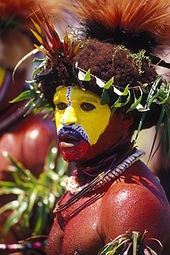 Huli man from the Southern Highlands, Papua New Guinea. New Guinea has more than 1,000 indigenous languages.
Huli man from the Southern Highlands, Papua New Guinea. New Guinea has more than 1,000 indigenous languages. Main article: Indigenous peoples of OceaniaSee also: Category:Indigenous peoples of Oceania
Main article: Indigenous peoples of OceaniaSee also: Category:Indigenous peoples of OceaniaMany of the present-day Pacific Island nations in the Oceania region were originally populated by Polynesian, Melanesian and Micronesian peoples over the course of thousands of years. European colonial expansion in the Pacific brought many of these under non-indigenous administration. During the 20th century several of these former colonies gained independence and nation-states were formed under local control. However, various peoples have put forward claims for Indigenous recognition where their islands are still under external administration; examples include the Chamorros of Guam and the Northern Marianas, and the Marshallese of the Marshall Islands.
The remains of at least 25 miniature humans, who lived between 1,000 and 3,000 years ago, were recently found on the islands of Palau in Micronesia.[43]
In most parts of Oceania, indigenous peoples outnumber the descendants of colonists. Exceptions include Australia, New Zealand and Hawaii. According to the 2001 Australian census, indigenous Australians make up 2.4% of the total population, while in New Zealand 14.6% of the population identify at least partially as indigenous Māori, with slightly more than half (53%) of all Māori residents identifying solely as Māori. The Māori are indigenous to Polynesia and settled New Zealand relatively recently, the migrations were thought to have occurred between 1000–1200 CE. In New Zealand pre-contact Māori tribes were not a single people, thus the more recent grouping into tribal (iwi) arrangements has become a more formal arrangement in more recent times. Many Māori tribal leaders signed a treaty with the British, Treaty of Waitangi, so that the modern geo-political entity that is New Zealand was established by partial consent. However, the Māori language translation of the Treaty of Waitangi which they signed is worded ambiguously and does not fully match the English version. The treaty process gave British citizenship to the 'native' population. However, some of the British settlers ignored the Treaty of Waitangi and through some illegal acts of colonisation and war (though there were legitimate land sales between Maori and the settlers) Maori lost 95% of their land and resources from the 1850s through to the 1970s which resulted in the large scale socio-economic marginalization of the vast majority of Maori. Since the 1970s there has been a cultural renaissance by Maori, and a political drive to assert their Treaty rights to their land, resources and culture through the Waitangi Tribunal [4] process. This has resulted in the legal recognition of the Maori language and culture and has resulted in the return of some land, resources and money so that today Māori businesses have an estimated value of over NZD$14 billion. Māori have also formed an important political party.
The independent state of Papua New Guinea (PNG) has a majority population of indigenous societies, with some 700+ different tribal groups recognized out of a total population of just over 5 million. The PNG Constitution and other Acts identify traditional or custom-based practices and land tenure, and explicitly sets out to promote the viability of these traditional societies within the modern state. However, several conflicts and disputes concerning land use and resource rights continue to be observed between indigenous groups, the government and corporate entities.
Rights, issues and concerns
Part of a series on Indigenous rights 
Rights Human rights · Racial Discrimination
Self-determination · Forced assimilation
Forced relocation · Cultural heritage
Freedom of religion · Cultural diversity
Land rights · Traditional knowledge
Intellectual property · Language
Land use planning · Right to Identity
Conflict Resolution · Gender equalityGovernmental organizations UNPFII · ACHPR · AADNC · Arctic Council
FUNAI · Council of Indigenous Peoples
CDI · NCIP · Bureau of Indian AffairsNGOs and political groups Amazon Watch · AFN · CAP · COICA
CONAIE · Cultural Survival · EZLN · fPcN
IPACC · IPCB · IWGIA · NARF · ONIC
Survival International · UNPO · (more)Issues Colonialism · Civilizing mission / Manifest Destiny
Cultural genocide · Postdevelopment theory
Bantustan · Indian reservation · Indian reserveLegal Representation ILO 169 · United Nations Declaration Related Categories Organizations · Politics · Books · Activists
Publications · Documentaries · MoviesWherever indigenous cultural identity is asserted, some particular set of societal issues and concerns may be voiced which either arise from (at least in part), or have a particular dimension associated with, their indigenous status. These concerns will often be commonly held or affect other societies also, and are not necessarily experienced uniquely by indigenous groups.
Despite the diversity of Indigenous peoples, it may be noted that they share common problems and issues in dealing with the prevailing, or invading, society. They are generally concerned that the cultures of Indigenous peoples are being lost and that indigenous peoples suffer both discrimination and pressure to assimilate into their surrounding societies. This is borne out by the fact that the lands and cultures of nearly all of the peoples listed at the end of this article are under threat. Notable exceptions are the Sakha and Komi peoples (two of the northern indigenous peoples of Russia), who now control their own autonomous republics within the Russian state, and the Canadian Inuit, who form a majority of the territory of Nunavut (created in 1999).
It is also sometimes argued that it is important for the human species as a whole to preserve a wide range of cultural diversity as possible, and that the protection of indigenous cultures is vital to this enterprise.
An example of this occurred in 2002 when the Government of Botswana expelled all the Kalahari Bushmen known as the San from their lands[44] on which they had lived for at least twenty thousand years. President Festus Mogai has described the Bushmen as "stone age creatures"[45] and a minister for local government, Margaret Nasha, likened public criticism of their eviction to criticism of the culling of elephants.[46] In 2006, the Botswanan High Court ruled that the Bushmen had a right to return to their land in the Central Kalahari Game Reserve.[47][48]
Health Issues
In December 1993, the United Nations General Assembly proclaimed the International Decade of the World's Indigenous People, and requested UN specialized agencies to consider with governments and indigenous people how they can contribute to the success of the Decade of Indigenous People, commencing in December 1994. As a consequence, the World Health Organization, at its Forty-seventh World Health Assembly established a core advisory group of indigenous representatives with special knowledge of the health needs and resources of their communities, thus beginning a long-term commitment to the issue of the health of indigenous peoples.[49]
The WHO notes, that "Statistical data on the health status of indigenous peoples is scarce. This is especially notable for indigenous peoples in Africa, Asia and eastern Europe", but snapshots from various countries, where such statistics are available, show that indigenous people are in worse health than the general population, in advanced and developing countries alike: higher incidence of diabetes in some regions of Australia;[50] higher prevalence of poor sanitation and lack of safe water among Twa households in Rwanda;[51] a greater prevalence of childbirths without prenatal care among ethnic minorities in Vietman;[52] suicide rates among Inuit youth in Canada are eleven times higher than the national average;[53] infant mortality rates are higher for indigenous peoples everywhere.[54]
Accredited organizations
See also: List of indigenous rights organizationsVarious organizations are devoted to the preservation or study of indigenous peoples. Of these, several have widely recognized credentials to act as an intermediary or representative on behalf of indigenous peoples' groups, in negotiations on indigenous issues with governments and international organizations. These include:
- African Commission on Human and Peoples' Rights (ACHPR)
- Center for World Indigenous Studies
- Cultural Survival
- Friends of Peoples Close to Nature (fPcN)
- Incomindios Switzerland
- Indigenous Dialogues
- Indigenous Peoples of Africa Co-ordinating Committee (IPACC)
- International Work Group for Indigenous Affairs (IWGIA)
- Survival International
- Society for Threatened Peoples (GfbV)
International Day of the World's Indigenous People
Main article: International Day of the World’s Indigenous PeopleThe International Day of the World's Indigenous People falls on August 9 as this was the date of the first meeting in 1982 of the United Nations Working Group of Indigenous Populations of the Subcommission on Prevention of Discrimination and Protection of Minorities of the Commission on Human Rights.
The UN General Assembly decided on 23 December 1994, that the International Day of the World's Indigenous People should be observed on August 9 every year during the International Decade of the World's Indigenous People (resolution 49/214). Later on 20 December 2004 the assembly decided to continue observing the International Day of Indigenous People every year during the Second International Decade of the World's Indigenous People (2005–2014) (resolution 59/174).[55]
Knowledge and culture
Main article: Traditional knowledgeThe preservation and investigation of specialized Indigenous knowledge, particularly in relation to the resources of the natural environment with which the society is associated, is a goal of both the Indigenous and the societies who thereby seek to identify new resources and benefits (example: partnerships established to research biological extracts from vegetation in the Amazon rainforests).
For some people (e.g. Indigenous communities from India, Brazil, and Malaysia and some NGOs such as GRAIN and Third World Network),[clarification needed] Indigenous peoples have often been victims of biopiracy when they are subjected to unauthorized use of their natural resources,[citation needed] of their traditional knowledge on these biological resources, of unequal share of benefits between them and a patent holder.
Viewpoints
A range of differing viewpoints and attitudes have arisen from the experience and history of contact between Indigenous and "non-indigenous" communities. The cultural, regional and historical contexts in which these viewpoints have developed are complex, and many competing viewpoints exist simultaneously in any given society, albeit promulgated with greater or lesser force depending on the extent of cross-cultural exposure and internal societal change. These views may be noted from both sides of the relationship.
Indigenous viewpoints
Indigenous peoples are increasingly faced with threats to their sovereignty, environment, and access to natural resources. Examples of this can be the deforestation of tropical rainforests where many native tribe's subsistence lifestyles are threatened. Assimilative colonial policies resulted in ongoing issues related to aboriginal child protection.
Non-indigenous viewpoints
Indigenous peoples have been denoted primitives, savages, or uncivilized. These terms were common during the heights of European colonial expansion, but still continue in modern times.[56] During the 17th century, indigenous peoples were commonly labeled "uncivilized". Whilst there was a swell in bringing back creative elements of classical antiquity in artistic pursuits, there was also the not so creative side of regurgitating xenophobic ideas from that period. Some philosophers such as Thomas Hobbes considered indigenous people to be merely 'savages', while others are purported to have considered them to be "noble savages". Those who were close to the Hobbesian view tended to believe themselves to have a duty to civilize and modernize indigenes. Although anthropologists, especially from Europe, used to apply these terms to all tribal cultures, it has fallen into disfavor as demeaning and, according to anthropologists, inaccurate (see tribe, cultural evolution). Survival International runs a campaign to stamp out media portrayal of indigenous peoples as 'primitive' or 'savages'.[57] Friends of Peoples Close to Nature considers not only that indigenous culture should be respected as not being inferior, but also sees their way of life as a lesson of sustainability and a part of the struggle within the "corrupted" western world, from which the threat stems.[58]
After World War I, however, many Europeans came to doubt the value of civilization. At the same time, the anti-colonial movement, and advocates of indigenous peoples, argued that words such as "civilized" and "savage" were products and tools of colonialism, and argued that colonialism itself was savagely destructive.
In the mid 20th century, European attitudes began to shift to the view that indigenous and tribal peoples should have the right to decide for themselves what should happen to their ancient cultures and their ancestral lands.
Several criticisms of the concept of indigenous peoples are:
- Peoples have invaded or colonized each other's lands since before recorded history and so the division into indigenous and non-indigenous is a matter of judgment. Even in recent centuries there are difficulties: for example, are the Zulu people indigenous to South Africa?
- Lumping indigenous peoples into one group ignores the vast amounts of diversity among them and at the same time imposes a uniform identity on them, which may not be historically accurate.
See also
- Collective rights
- Colonialism
- Ethnic minority
- Human rights
- The Image Expedition
- Indigenous intellectual property
- Intangible Cultural Heritage
- Isuma
- Uncontacted peoples
- United Nations Permanent Forum on Indigenous Issues
- Unrepresented Nations and Peoples Organization
- List of ethnic groups
- Indigenous Peoples Climate Change Assessment Initiative
References
- ^ Smith, Linda Tuhiwai. Decolonizing Methodologies: Research and Indigenous Peoples. London: Zed Books, 1999. ISBN 978-1-85649-624-7. p. 7
- ^ a b Sanders, Douglas. 1999. Indigenous peoples: Issues of definition. International Journal of Cultural Property. No. 8 pp. 4 – 13.
- ^ a b "Operational Policy 4.10 – Indigenous Peoples". http://web.worldbank.org/WBSITE/EXTERNAL/PROJECTS/EXTPOLICIES/EXTOPMANUAL/0,,contentMDK:20553653~menuPK:4564185~pagePK:64709096~piPK:64709108~theSitePK:502184,00.html.
- ^ "Terminlogy of Native Aboriginal". http://www.aidp.bc.ca/terminology_of_native_aboriginal_metis.pdf.
- ^ "World Directory of Minorities and Indigenous Peoples – Philippines: Overview, 2007", UNHCR | Refworld.
- ^ "Negritos, Australian Aborigines, and the proto-sundadont dental pattern: The basic populations in East Asia". Wiley InterScience. http://www3.interscience.wiley.com/cgi-bin/abstract/110486797/ABSTRACT?CRETRY=1&SRETRY=0. Retrieved 2009-10-23.[dead link]
- ^ a b c d e "United NationsDeclaration on the Rights of Indigenous Peoples (A/RES/61/295)". United Nations. UNPFII. http://www.un.org/esa/socdev/unpfii/documents/DRIPS_en.pdf. Retrieved 2009-10-23.
- ^ a b c "Frequently Asked Questions: Declaration on the Rights of Indigenous Peoples" (PDF). United Nations Permanent Forum on Indigenous Issues. http://www.un.org/esa/socdev/unpfii/documents/FAQsindigenousdeclaration.pdf. Retrieved 2009-10-23.
- ^ WGIP (2001). Indigenous Peoples and the United Nations System. Office of the High Commissioner for Human Rights, United Nations Office at Geneva. http://www.unhchr.ch/html/racism/indileaflet1.doc.[dead link]
- ^ a b "Indigenous issues". International Work Group on Indigenous Affairs. http://www.iwgia.org/sw155.asp. Retrieved September 5, 2005.
- ^ Acharya, Deepak and Shrivastava Anshu (2008): Indigenous Herbal Medicines: Tribal Formulations and Traditional Herbal Practices, Aavishkar Publishers Distributor, Jaipur- India. ISBN 978-81-7910-252-7. pp 440
- ^ Bartholomew Dean and Jerome Levi (eds.) At the Risk of Being Heard: Indigenous Rights, Identity and Postcolonial States University of Michigan Press (2003)[1]
- ^ No 'indigenous', reiterates Shafique. bdnews24.com (2011-06-18). Retrieved on 2011-10-11.
- ^ Ministry of Chittagong Hill Tracts Affairs
- ^ INDIGENOUS PEOPLEChakma Raja decries non-recognition. bdnews24.com (2011-05-28). Retrieved on 2011-10-11.
- ^ 'Define terms minorities, indigenous'. bdnews24.com (2011-05-27). Retrieved on 2011-10-11.
- ^ Disregarding the Jumma. Himalmag.com. Retrieved on 2011-10-11.
- ^ Minucius Felix, The Octavius
- ^ Robert Louis Wilken (10 April 2003). The Christians as the Romans saw them. Yale University Press. ISBN 978-0-300-09839-6. http://books.google.com/books?id=TbFfhy510NQC. Retrieved 11 October 2011.
- ^ Gentry, Kenneth L. Jr, 1989, Before Jerusalem Fell, Institute for Christian Economics, Tyler, Texas
- ^ Old World Contacts/Colonists/Canary Islands. Ucalgary.ca (1999-06-22). Retrieved on 2011-10-11.
- ^ Little-known Indian tribe spotted in Peru's Amazon. Alertnet.org. Retrieved on 2011-10-11.
- ^ Dean, Bartholomew 2009 Urarina Society, Cosmology, and History in Peruvian Amazonia, Gainesville: University Press of Florida ISBN 978-081303378 [2]
- ^ "Civilization.ca-Gateway to Aboriginal Heritage-Culture". Canadian Museum of Civilization Corporation. Government of Canada. May 12, 2006. http://www.civilization.ca/cmc/exhibitions/tresors/ethno/etb0170e.shtml. Retrieved 2009-09-18.
- ^ "Inuit Circumpolar Council (Canada)-ICC Charter". Inuit Circumpolar Council > ICC Charter and By-laws > ICC Charter. 2007. http://inuitcircumpolar.com/index.php?auto_slide=&ID=374&Lang=En&Parent_ID=¤t_slide_num=. Retrieved 2009-09-18.
- ^ "In the Kawaskimhon Aboriginal Moot Court Factum of the Federal Crown Canada" (PDF). Faculty of Law. University of Manitoba. 2007. p. 2. http://www.umanitoba.ca/law/newsite/kawaskimhon_factums/FINALWrittenSubmissionsofFederalCrown_windsor.pdf. Retrieved 2009-09-18.
- ^ "Words First An Evolving Terminology Relating to Aboriginal Peoples in Canada". Communications Branch of Indian and Northern Affairs Canada. 2004. http://www.collectionscanada.gc.ca/webarchives/20071114225541/http://www.ainc-inac.gc.ca/pr/pub/wf/trmrslt_e.asp?term=12. Retrieved 2010-06-26.
- ^ "Terminology of First Nations, Native, Aboriginal and Metis" (PDF). Aboriginal Infant Development Programs of BC. 2009. http://www.aidp.bc.ca/terminology_of_native_aboriginal_metis.pdf. Retrieved 2010-06-26.
- ^ "Aboriginal Identity (8), Sex (3) and Age Groups (12) for the Population of Canada, Provinces, Territories, Census Metropolitan Areas and Census Agglomerations, 2006 Census – 20% Sample Data". Census > 2006 Census: Data products > Topic-based tabulations >. Statistics Canada, Government of Canada. 06/12/2008. http://www12.statcan.ca/english/census06/data/topics/RetrieveProductTable.cfm?ALEVEL=3&APATH=3&CATNO=&DETAIL=0&DIM=&DS=99&FL=0&FREE=0&GAL=0&GC=99&GK=NA&GRP=1&IPS=&METH=0&ORDER=1&PID=89122&PTYPE=88971&RL=0&S=1&ShowAll=No&StartRow=1&SUB=0&Temporal=2006&Theme=73&VID=0&VNAMEE=&VNAMEF=&GID=837928. Retrieved 2009-09-18.
- ^ "Assembly of First Nations - Assembly of First Nations-The Story". Assembly of First Nations. http://www.afn.ca/article.asp?id=59. Retrieved 2009-10-02.
- ^ "Civilization.ca-Gateway to Aboriginal Heritage-object". Canadian Museum of Civilization Corporation. May 12, 2006. http://www.civilization.ca/cmc/exhibitions/tresors/ethno/etb0000e.shtml. Retrieved 2009-10-02.
- ^ Brazil urged to protect Indians. BBC News (2005-03-30). Retrieved on 2011-10-11.
- ^ Brazil sees traces of more isolated Amazon tribes. Reuters.com. Retrieved on 2011-10-11.
- ^ "Natives in Russia's far east worry about vanishing fish". Agence France-Presse. The Economic Times. February 25, 2009. http://economictimes.indiatimes.com/environment/flora--fauna/natives-in-russias-far-east-worry-about-vanishing-fish/articleshow/4203839.cms. Retrieved March 5, 2011.
- ^ Recognition at last for Japan's Ainu, BBC NEWS
- ^ Blust, R. (1999), "Subgrouping, circularity and extinction: some issues in Austronesian comparative linguistics" in E. Zeitoun & P.J.K Li, ed., Selected papers from the Eighth International Conference on Austronesian Linguistics. Taipei: Academia Sinica
- ^ Fox, James J."Current Developments in Comparative Austronesian Studies"PDF (105 KB). Paper prepared for Symposium Austronesia Pascasarjana Linguististik dan Kajian Budaya. Universitas Udayana, Bali 19–20 August 2004.
- ^ Diamond, Jared M. "Taiwan's gift to the world"PDF (107 KB). Nature, Volume 403, February 2000, pp. 709–710
- ^ temporary rules over parts of Europe by non-European powers include Avar Khaganate (c.560s–800), Al-Andalus (711–1492), Emirate of Sicily (831–1072), the Mongol/Tatar invasions (1223–1480), and Ottoman control of the Balkans (1389–1878)
- ^ Mark Kurlansky (9 January 2001). The Basque History of the World. Knopf Canada. ISBN 978-0-676-97366-2. http://books.google.com/books?id=ZGs-PgAACAAJ. Retrieved 11 October 2011.
- ^ Caucasian peoples. Britannica.com. Retrieved on 2011-10-11.
- ^ Catford, J C (1977). "Mountain of Tongues: The Languages of the Caucasus". Annual Review of Anthropology 6: 283. doi:10.1146/annurev.an.06.100177.001435.
- ^ Pygmy human remains found on rock islands, Science | The Guardian
- ^ "afrol News – Botswana govt gets tougher on San tribesmen". Afrol.com. http://www.afrol.com/News2002/bot002_san_supplies.htm. Retrieved 2010-06-30.
- ^ Simpson, John (2005-05-02). "Africa | Bushmen fight for homeland". BBC News. http://news.bbc.co.uk/2/hi/africa/4480883.stm. Retrieved 2010-06-30.
- ^ Monbiot, George (21 March 2006). "Who really belongs to another age – bushmen or the House of Lords?". The Guardian (London). http://www.guardian.co.uk/Columnists/Column/0,,1735617,00.html. Retrieved 5 May 2010.
- ^ "Botswana bushmen ruling accepted". BBC News. 18 December 2006. http://news.bbc.co.uk/2/hi/africa/6191185.stm. Retrieved 5 May 2010.
- ^ [3][dead link]
- ^ "RESOLUTIONS AND DECISIONS. WHA47.27 International Decade of the World's Indigenous People. The Forty-seventh World Health Assembly," (PDF). World Health Organization. http://www.who.int/ethics/activities/WHA47.27.pdf. Retrieved 2011-04-17.
- ^ Diabetes in Indigenous Populations, Anthony J. Hanley, Medscape Today
- ^ Health of Indigenous Peoples in Africa, Lancet Series on Indigenous Health, Vol. 367, June 2006, p. 194
- ^ Health and Ethnic Minorities in Viet Nam, Technical Series No. 1, June 2003, WHO, p. 10
- ^ Facts on Suicide Rates, First Nations and Inuit Health, Health Canada
- ^ "Health of indigenous peoples". Health Topics A to Z. http://allcountries.org/health/health_of_indigenous_peoples.html. Retrieved 2011-04-17.
- ^ International Day of the World's Indigenous People – 9 August
- ^ See Oliphant v. Suquamish Indian Tribe, 435 U.S. 191 (1978); also see Robert Williams, Like a Loaded Weapon
- ^ Survival International website – About Us/FAQ
- ^ friends of Peoples close to Nature website – Our Ethos and statement of principles[dead link]
Further reading
- United Nations Working Group on Indigenous Populations, from Study of the Problem of Discrimination Against Indigenous Populations, J. Martinez Cobo, United Nations Special Rapporteur (1987)
- Report of the African Commission's Working Group of Experts on Indigenous Populations/Communities November 2003
- FRITZ Jean-Claude, La nouvelle question indigène. Peuples autochthones et ordre mondial (en co-direction avec Frédéric Déroche, Gérard Fritz et Raphaël Porteilla), Paris, L'Harmattan, 2006.
- FRITZ Jean-Claude, L'humanité face à la mondialisation. Droit des peuples et environnement (en co-direction avec Charalambos Apostolidis et Gérard Fritz), Paris, L'Harmattan, 1997.
- Indigenous Peoples and Environmental Issues: An Encyclopedia, by Bruce E. Johansen. Westport, Connecticut, Greenwood Press, 2003. 506p., ISBN 978-0-313-32398-0
- Henriksen, John B. (2001). "Implementation of the Right of Self-Determination of Indigenous Peoples" (PDF). Indigenous Affairs (Copenhagen: International Work Group for Indigenous Affairs) 3/2001: pp. 6–21. ISSN 1024-3283. OCLC 30685615. http://www.iwgia.org/graphics/Synkron-Library/Documents/publications/Downloadpublications/IndigenousAffairs/selfdetermination.pdf. Retrieved 2007-09-01
External links
Institutions
- UNEP Indigenous People's Website
- IFAD and indigenous peoples (International Fund for Agricultural Development, IFAD)
- IPS Inter Press Service News on indigenous peoples from around the world
Indigenous studies
- Indigenous Peoples in Brazil. Instituto Socioambiental (ISA)
- Indigenous Peoples Issues & Resources
- Janssen, D. F., Growing Up Sexually. Volume I. World Reference Atlas [full text]
Indigenous peoples of the world by continent Indigenous peoples by geographic regionsEthnicity Related concepts Clan · Ethnic group · Ethno-linguistic group · Ethno-religious group · Indigenous peoples · Meta-ethnicity · Minority group · Nation · Nationality · Panethnicity · Population · Race · TribeEthnology Ethnic groups by region Africa (Arab League) · America (Indigenous · Canada · United States · Central America · South America) · Asia (Central Asia · East Asia · Northern Asia · South Asia · Southeast Asia · West Asia) · Australia (Indigenous) · Europe · Oceania (Indigenous · European)Identity and ethnogenesis Multiethnic society Ideology and ethnic conflict Categories:- Indigenous peoples
- Ethnic groups
Wikimedia Foundation. 2010.

